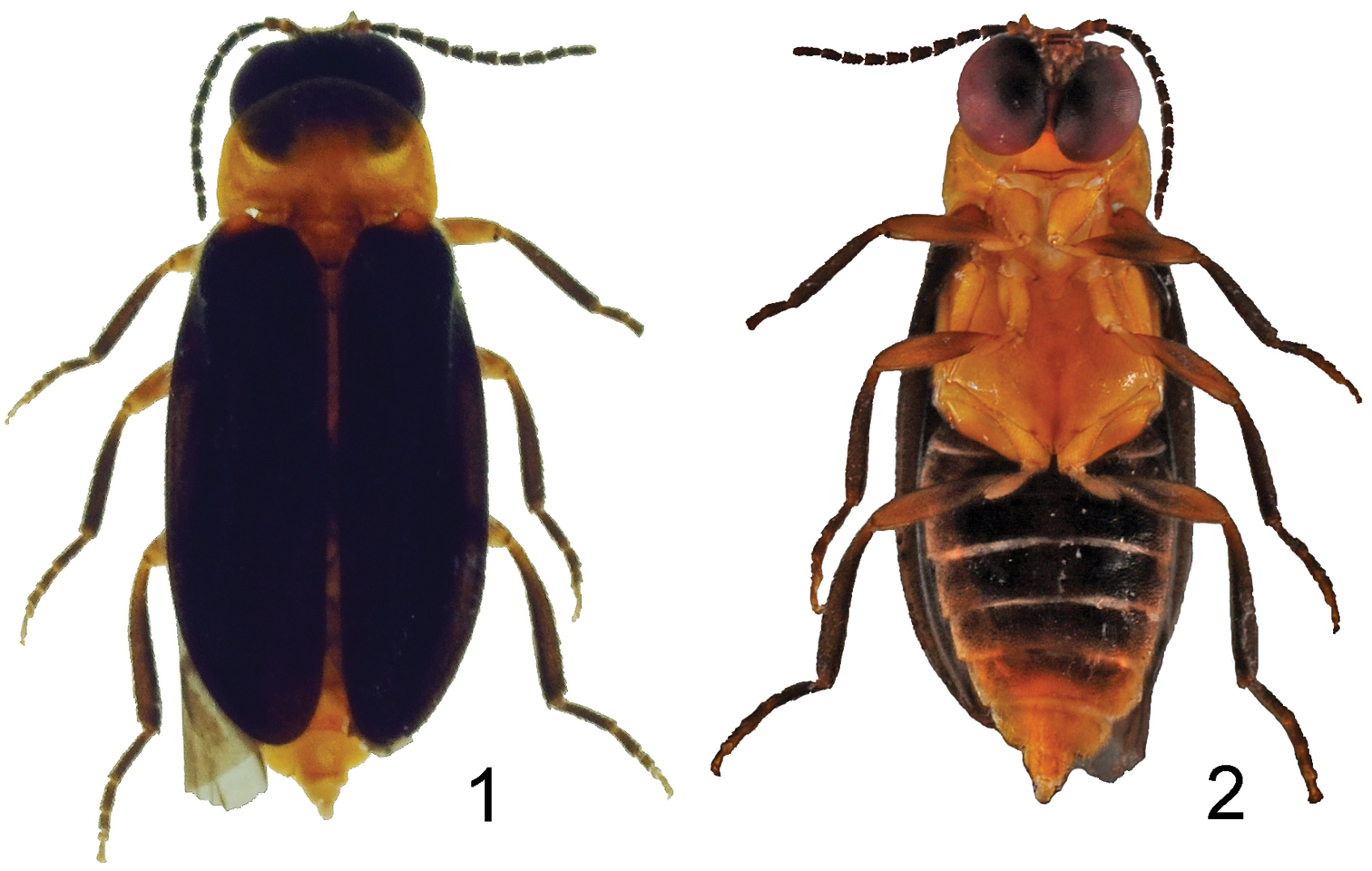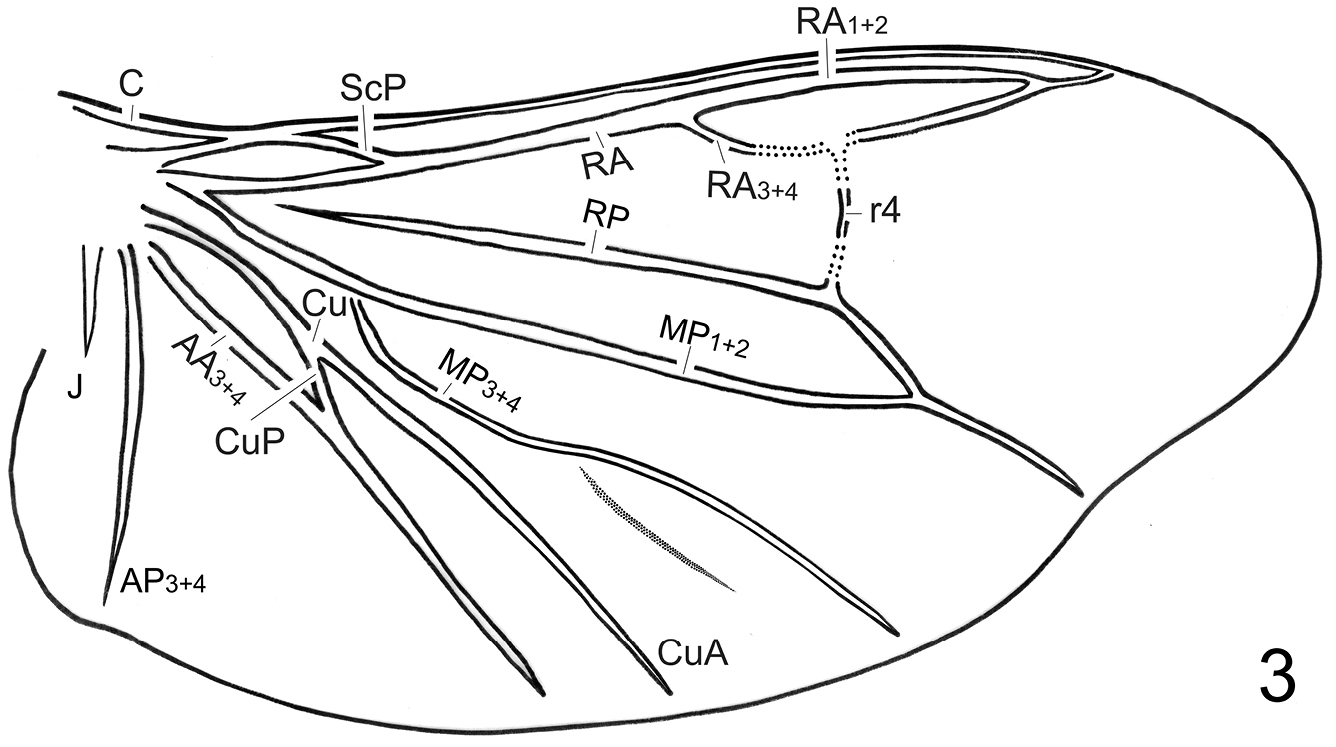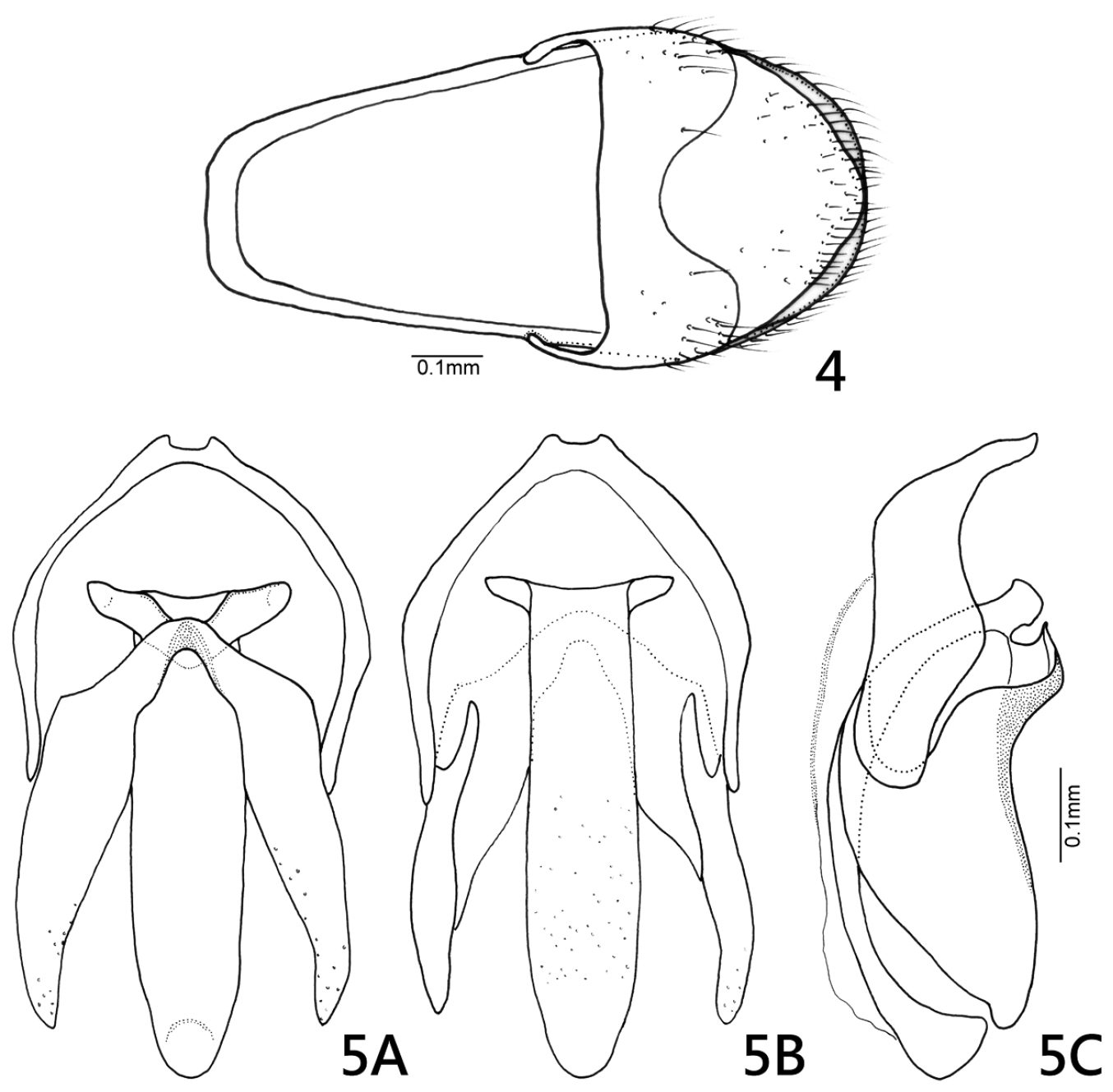ZooKeys 378: 41–47, doi: 10.3897/zookeys.378.6435
Description of Oculogryphus shuensis sp. n. (Coleoptera, Lampyridae), the first species of the genus in the Sino-Japanese realm, with a modified key to the subfamily Ototretinae
Ming-Luen Jeng 1,†, Michael S. Engel 2,‡
1 Department of Biology, National Museum of Natural Science, No. 1, Guanqian Rd., Taichung City 40453, Taiwan, R.O.C.
2 Division of Entomology, Natural History Museum, and Department of Ecology & Evolutionary Biology, University of Kansas, 1501 Crestline Drive – Suite 140, Lawrence, Kansas 66045, USA
Citation: Jeng M-L, Engel MS (2014) Description of Oculogryphus shuensis sp. n. (Coleoptera, Lampyridae), the first species of the genus in the Sino-Japanese realm, with a modified key to the subfamily Ototretinae. ZooKeys 378: 41–47. doi: 10.3897/zookeys.378.6435
Abstract
A new species of the lampyrid genus Oculogryphus Jeng, Engel, and Yang, O. shuensis sp. n. from China (Sichuan Province) is described and figured. The genus previously was known only from Vietnam, and the new species is the first representative of the genus in the Sino-Japanese zoogeographic realm. Some morphological variations of Oculogryphus and the allied genus Stenocladius are discussed and a modification to the most recent key to ototretine genera is proposed to accommodate Oculogryphus.
Keywords
Oculogryphus, Lampyridae, Ototretinae, Stenocladius, China, key
Introduction
Oculogryphus is a small beetle genus currently composed of two species known only from northern Vietnam (Jeng et al. 2007, 2011). The genus is morphologically distinctive in having enlarged compound eyes which are closely approximate ventrally and deeply emarginate on the posterior upper margin laterally. It was thought to be en enigmatic taxon with a mosaic of features intermingling those of Rhagophthalmidae, Luciolinae, Lampyrinae, and the ototretine-ototretadriline complex when established (Jeng et al. 2007). Subsequently the genus was revealed to be closely related to the ototretine genus Stenocladius Fairmaire s.str. based on a comprehensive phylogenetic study of Lampyridae based on male morphology (Jeng 2008, Jeng et al. 2011). In the most current revision of Ototretinae, Janisova and Bocakova (2013) synonymized the subfamily Ototretadrilinae and accordingly redefined the limits of the group. Eighteen ototretine genera were reviewed or revised, diagnostically characterized, and a key based on male characters, especially of aedeagal morphology, was given, but Oculogryphus was overlooked.
Here we describe a third species of the genus, recently collected in Sichuan Province, China. The new species is the first representative of the genus in the Sino-Japanese zoogeographic realm (sensu Holt et al. 2013). Some morphological variations of Oculogryphus and Stenocladius are discussed in detail and a modification to Janisova and Bocakova’s (2013) key to ototretine genera is proposed so as to include Oculogryphus.
Material and methods
The methodology and morphological terminology used herein follows that of Jeng et al. (2007, 2011). The body length (BL) is the sum of the pronotal and elytral lengths (PL and EL, respectively) plus length of those exposed portions of the head from the pronotum. Body width is considered as twice the elytral width (BW = 2EW). Pronotal width is abbreviated as PW. The nomenclature of the hind wing venation follows that of Kukalová-Peck and Lawrence (2004). In reporting label data the symbol “/” indicates separate lines on a single label. The holotype will be deposited in the insect collection of the Chinese Academy of Sciences, Beijing (CAS) and the paratype in the National Museum of Natural Science (NMNS), Taichung, Taiwan.
Results
Holotype.
♂, “CHINA: Sichuan Province/ Chongqing City, Jijiang Distr./ Shuikousi, by net/ 24.VI.2013/ YT Wang leg.
Paratype.
1 ♂, “CHINA: Sichuan Province/ Chongqing City, Jiangjin Distr./ Dawopu, by FIT/, 22.VI.2013/ YT Wang leg.
Type-locality.
China, Sichuan Province, Chongqing City, Jijiang Distr., Shuikousi, 18°22'N, 106°13'E.
Diagnosis.
In comparison with the other two documented species, Oculogryphus shuensis sp. n. more closely resembles Oculogryphus bicolor Jeng, Engel et Branham than it does Oculogryphus fulvus Jeng. For example, the new species has a broader elytral epipleura, more slender metatibia, and more elongate parameres, much like Oculogryphus bicolor. The new species can be differentiated easily from the others by its highly contrasting bicoloration on the dorsum (Fig. 1) and black abdominal ventrites 1–5 (Fig. 2). It additionally differs from Oculogryphus bicolor by having a subparallel-sided median lobe of the aedeagus and a strongly sinuate basal margin to the parameres in lateral aspect (Fig. 5).
Figures 1–2.
Habitus of holotype of Oculogryphus shuensis sp. n. 1 dorsal aspect 2 ventral aspect.
Description.
♂: BL: 6.7–7.1 mm; BW: 2.8–3.1 mm; PW/PL = 1.5–1.6; EL/ EW = 3.4–3.7; EL/PL = 3.7–3.9; BW/PW = 1.3–1.4. The species is very similar to Oculogryphus bicolor in general morphology and those characteristics need not be repeated here (vide Description of Oculogryphus bicolor in Jeng et al. 2011). As described for Oculogryphus fulvus and Oculogryphus bicolor except: head capsule and antennae black; pronotum and mesoscutellum orange; elytra and epipleura opaquely black except humeri brown; thoracic sternites yellowish brown; all coxae, trochanters and subapices of femora yellowish brown, other parts of legs otherwise black; abdominal ventrites 1–5 and basal half of 6 opaquely black, apical half of 6 and 7–8 yellowish brown. Venation of hind wing (Fig. 3) similar to that of Oculogryphus fulvus, with MP4 absent or faint. Aedeagal sheath about 0.89 mm in length and 0.42 mm in width; abdominal tergites IX and X clearly recognizable individually; sternite IX with basal corners somewhat squared (Fig. 4). Aedeagus (Fig. 5) about 0.66 mm in length and 0.37 mm broad; median lobe slightly surpassing parameres apically, subparallel-sided dorso-ventrally, with apex significantly dilated in lateral aspect; parameres elongate dorso-ventrally, strongly sinuate on basal margin laterally; basal piece somewhat horseshoe-shaped, with a median notch in caudal margin.
Figure 3.
Sketch of right hind wing of Oculogryphus shuensis sp. n., male, modified from that of Oculogryphus bicolor to show venation.
Figures 4–5.
Oculogryphus shuensis sp. n., male. 4 aedeagal sheath, dorsal aspect 5 male genitalia, dorsal (A), ventral (B), and lateral (C) aspects.
♀: Unknown.
Etymology.
The specific epithet is derived from the old name of Sichuan (Shu), where the new species was found.
Phenology.
Males appear at least in June.
Key to species of Oculogryphus
| 1 |
Pronotum and elytra highly contrasting in ground coloration, elytra black and pronotum orange; abdominal ventrites 1–5 and basal half of 6 black, apical half of 6 and 7–8 yellowish brown (China: Sichuan) |
Oculogryphus shuensis sp. n. |
| – |
Pronotum and elytra sharing similar or identical ground coloration, mostly yellowish brown; abdominal ventrites exclusively yellowish brown |
2 |
| 2 |
Elytra with base, lateral margins, and sutures yellowish brown and disc smoky brown; body size larger (body length 6.2–8.2 mm); male genitalia with median lobe slightly surpassing apex of parameres (Vietnam) |
Oculogryphus bicolor Jeng, Engel & Branham |
| – |
Elytra more or less uniformly brown in coloration; body size smaller (body length 6.0 mm); male genitalia with median lobe far surpassing apex of parameres by about 1/3 length of median lobe (Vietnam) |
Oculogryphus fulvus Jeng |
Discussion
We examined the type material of the type species and several other species of the ototretine genera deposited in the Muséum national d’Histoire naturelle, Paris (MNHN). Oculogryphus is doubtless a member of the newly-defined Ototretinae and appears allied to a subgroup whose lateroposterior angles of the pronotum are less prominent. Following Janisova and Bocakova’s (2013) key, Oculogryphus falls intermediate between Falsophaeopterus Pic and Stenocladius in couplet 17 – it shares filiform antennae with Falsophaeopterus but has an aedeagal morphology more resembling that of Stenocladius. Although similar, the morphological particulars of Oculogryphus differ notably from the other two genera. For example, the filiform antennae of Oculogryphus are comparatively short and slender in relation to those of Falsophaeopterus which are more or less depressed, long and varyingly serrate. As to the aedeagus, the length of the parameres in relation to the phallus (median lobe) and whether the phallobase (basal piece) has a marginal emargination were used to separate Stenocladius from Falsophaeopterus in Janisova and Bocakova’s (2013) key. It is true that the parameres of Falsophaeopterus (including its subgenus Mimophaeopterus Pic) are about as long as the phallus, but this is quite variable in Stenocladius (as long as 2/3 of the phallus to slightly shorter (6/7), (cf. Kawashima 1999, Janisova and Bocakova 2013)). The ratios of phallus/phallobase and paramere/phallobase also varied greatly among species of Stenocladius but seem stable in Falsophaeopterus, which always has the phallobase shortest among the aedeagal sclerites. The ratios of aedeagal sclerites of Oculogryphus show a pattern similar to that observed for Stenocladius (Jeng et al. 2007, 2011, present study). The notch on caudal margin of the phallobase is quite clear in the type species of Stenocladius, Stenocladius davidis Fairmaire (Janisova and Bocakova 2013), but is faint or absent in some others (Kawashima 1999). Similar variation exists among species of Oculogryphus, too (Jeng et al. 2007, 2011, present study). The aforementioned features appear not sufficiently reliable to be diagnostically meaningful in differentiating these genera in a key.
Oculogryphus is distinct from all of the other ototretine genera by its large compound eyes which are nearly contiguous ventrally and significantly emarginate on the posterior upper margin in males. The genae are mostly vertical, deeply lying between the enlarged compound eyes and separated by a fused gular suture (Fig. 2). Within Ototretinae, only a few unidentified species of Stenocladius from China and SE Asia are comparable to Oculogryphus in terms of compound eye size. Generally the compound eyes of species of Stenocladius are of median size, hemispherical frontally, nearly spherical laterally and separated from each other ventrally by 0.9× to 1.5× ventral width of an individual compound eye (Janisova and Bocakova 2013). The genae and gula between the compound eyes are visible ventrally. In contrast, the large-eyed species of Stenocladius have their compound eyes approximate ventrally, separated from each other by scarcely visible genae and a narrow gula and are weakly and broadly-rounded emarginate on the posterior margin. Simultaneously, they also possess shorter antennae and antennal branches in contrast to the typical species of the genus. The combination of enlarged compound eyes and short antennae is likely a character suite adapted to a visually-oriented mate-searching strategy at night. Though enlarged and deeply emarginate compound eyes have evolved in parallel or by convergence among several lampyrid (Ototretinae, Luciolinae, and Lampyrinae) and rhagophthalmid (Rhagophthalmus Motschulsky, Menghuoius Kawashima and Satô, and Dioptoma Pascoe) lineages (Jeng et al. 2007), those of Oculogryphus are unique to the newly-defined Ototretinae. Herein we proposed a modification to Janisova and Bocakova’s (2013) key, partially adopted from Jeng et al. (2007) to include Oculogryphus:
| 17 |
Tibial spurs present; antennae serrate or filiform, with first flagellomere thicker or broader than scape if filiform |
Falsophaeopterus Pic |
| – |
Tibial spurs absent; antennae flabellate or filiform, with first flagellomere as thick as or more slender than scape if filiform |
18 |
| 18 |
Antennae filiform and short, reaching elytral base at most when in repose; compound eyes large, separated from each other by about half compound eye diameter frontally, ovoid in shape laterally, and with posterior upper margin deeply emarginate in about right angle |
Oculogryphus Jeng, Engel & Yang |
| – |
Antennae flabellate and long, reaching basal third or half of elytra when in repose; compound eyes medium to large, separated from each other by at least one compound eye diameter frontally, more or less round in shape laterally, with posterior upper margin never deeply emarginate in right angle |
Stenocladius Fairmaire |
Acknowledgements
We are grateful to Y-T. Wang for sending us material of the new species described herein and to M. Chang for taking photos of the holotype. Thanks are also due to T. Deuve (MNHN) for providing the material of ototretine species in his charge. This study was supported financially by the National Science Council, Republic of China, grants NSC100-2313-B-178-002-MY2 and NSC102-2313-B-178-003-MY3.
ReferencesHolt BG, Lessard JP, Borregaard MK, Fritz SA, Araújo MB, Dimitrov D, Fabre PH, Graham CH, Graves GR, Jønsson KA, Nogués-Bravo D, Wang Z, Whittaker RJ, Fjeldså J, Rahbek C (2013) An update of Wallace’s zoogeographic regions of the world. Science 339(6115): 74-78. doi:
10.1126/science.1228282Janisova K, Bocakova M (2013) Revision of the subfamily Ototretinae (Coleoptera: Lampyridae). Zoologischer Anzeiger 252(1): 1-19. doi:
10.1016/j.jcz.2012.01.001Jeng M-L (2008) Comprehensive phylogenetics, systematics, and evolution of neoteny of Lampyridae (Insecta: Coleoptera). PhD dissertation, University of Kansas, Lawrence, Kansas.
Jeng M-L, Branham MA, Engel MS (2011) A second species of
Oculogryphus (Coleoptera, Lampyridae), with notes on the phylogenetic affinity of the genus. Zookeys 97: 31-38. doi:
10.3897/zookeys.97.1223Kawashima I (1999) The lampyrid beetles of the genus
Stenocladius (Coleoptera, Lampyridae) of the Ryukyu Islands, Southwest Japan, with descriptions of two new species. Elytra 27(1): 141-158.
Kukalová-Peck J, Lawrence JF (2004) Relationships among coleopteran suborders and major endoneopteran lineages: Evidence from hind wing characters. European Journal of Entomology 101(1): 95-144.









